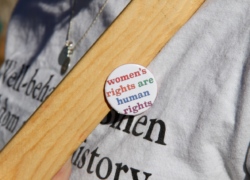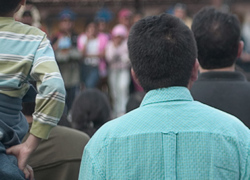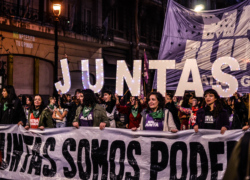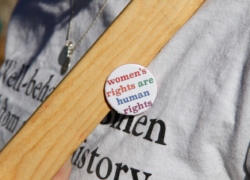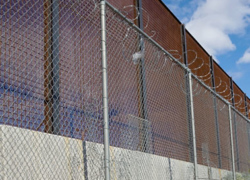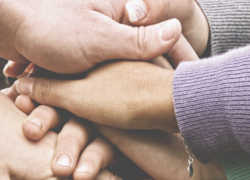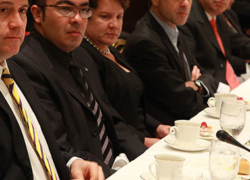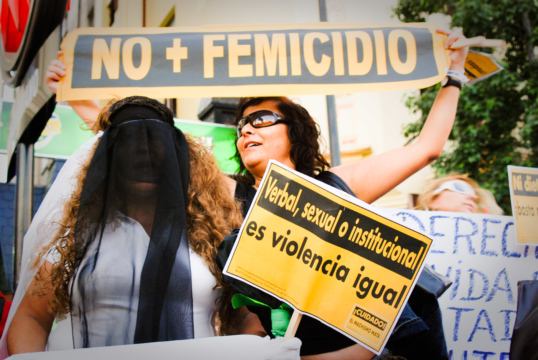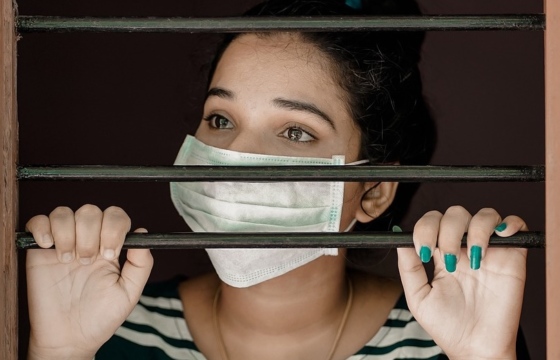The widespread outbreak of activism against gender-based violence in Latin America has captured the media and world’s attention. Since June 2015 when the first Ni Una Menos march took place in Buenos Aires, Argentina, there has been a sustained region-wide mass outcry for stronger, more effective policies and education on gender-based violence. Yet, just as there has been an emphatic call for raising awareness and effecting policy change, so too has there been a steady string of horrific cases of rape and femicides. Reported femicides, meaning the gender-related murder of women, and other forms of violence against women have been consistently high in Latin America compared to other regions of the world and, in most countries of the region the numbers have risen in the last decade. Impunity for offenders and a lack of official statistics on these crimes persist and governments are slow to address these challenges. The good news: the activist movement shows no signs of slowing down or giving up and small steps are being made in the right direction. The bad news: the small steps are very small.
The Inter-American Convention on the Prevention, Punishment, and Eradication of Violence against Women, known as the Convention of Belém do Pará, was adopted in 1994 and, as of August 2012, has been ratified by 32 of the 35 member states of the Organization of the American States. The Convention calls for the establishment of mechanisms – laws, educational campaigns, trainings, judicial procedures, and victim services, among others – for the protection and defense of women’s rights and to combat violence against women in all forms. It was the first convention of its kind in Latin America and has since led to the passing of gender-based policies and femicide laws in 16 countries. To name a few, in Ecuador femicide is punishable with 22 to 26 years in prison and in Costa Rica, with 20 to 35 years in prison. Argentina passed Law 26.485 in 2009, which increased the penalty for femicide to life imprisonment, requires mandatory compiling of domestic violence data, and recognizes five types of gender violence – physical, psychological, sexual, economic, and symbolic.In 2006, Brazil passed the Maria da Penha law—named after a victim who now suffers from paraplegia after being brutally assaulted by her husband—which expanded legal recognition of different forms of abuse against women, increased the penalty for offenders, established special domestic violence courts, and required the opening of 24-hour shelters for victimized women.
These policies, however, often end up simply as words on paper. They lack efficacy and are not enforced. The laws exist, but the judicial system does not implement them and society does not hold the government accountable to do so. Fabiana Túñez, the director of La Casa del Encuentro, an Argentine women’s rights NGO, laments that “Law 26.485 in itself is one of the strongest in Latin America, but some of its main points, such as the compiling of official statistics, continue to be ineffective.” Similar frustrations are seen across Latin American countries. Impunity rates are as high as 98 percent in some countries. Politicians lack the political will, police forces lack training, and the judicial system lacks funding to properly handle gender based violence cases.
These failures are due in large part to the deeply ingrained culture of machismo. It is the norm rather than the exception for the authorities to downplay the severity of reported cases and not follow through with punishments for offenders. Victims are often hesitant to report cases of domestic violence for fear of retribution from their aggressors or because they are aware that, in most instances, going to the police ends up being ineffective and more traumatic. Police will attempt to find blame on the woman’s part in cases of sexual assault, asking inappropriate and offensive questions pertaining to the provocativeness of the woman’s clothing, the promiscuity of her sexual conduct, or insinuating she actually enjoyed the sexual encounter being reported. In Brazil, at least 30 percent of reported cases of domestic violence do not move past the police station, as the extent of the incident is diminished in official reports. Cases of femicide may be ruled as suicides so as to bypass legally required actions if they were to be classified as femicides. According to the National Citizen Femicide Observatory, an alliance of 49 organizations that documents gender violence, in Mexico, only 16 percent of female murders in 2012 and 2013 were classified as femicides and only 1.6 percent of these resulted in a conviction.
Corruption and machismo in the judicial system affects every aspect of reporting a gender-based assault from the investigation to the absurd length of time that cases are held in limbo awaiting any decision or trial. Many women will report their partners for assault numerous times before any police action is taken. According to a survey conducted by the Presidential Adviser on Equality for Women, Martha Ordonez, more than half of Colombian officials believe that “what happens in private should be solved in privacy,” while 32 percent “don’t care” about domestic violence stories and 11 percent say that wives should forgive husbands for abuse committed while drunk. These problems with the way that society, government officials, and the police view violence against women are the reasons that policies were put into place, yet still nothing has changed.
The inefficacy of laws and the judicial system is of far greater concern when statistics on the violence that women face in Latin America are exposed. According to a 2011 Geneva Convention report, of the 25 countries with the highest rates of violence against women, 14 were in Latin America. A study conducted by La Casa del Encuentro shows that a woman is killed every 30 hours by a close male counterpart in Argentina. In 2015, the same Argentine organization recorded 286 femicides, up from 208 recorded femicides in 2008. In Guatemala, two women die on average per day due to a domestic violence incident, and in Brazil, an average of 15 women die per day. In Mexico, a woman is killed every four hours. According to the same Geneva Convention report, El Salvador ranks the highest in the world for femicides with 12 per 100,000 people. There were 630 femicides in 2011 in El Salvador and from January to October of 2015, there were 475.
Even more staggering are the statistics on rape or other forms of sexual assault that do not result in death. According to the Brazilian Public Safety Forum, 45,460 rapes were reported in 2015, yet the organization estimates that only 10 percent of victims actually file a report. According to the UN, a woman is assaulted every 15 seconds in São Paulo, Brazil’s largest city. In Mexico, more than 120,000 women are raped a year, which is approximately one rape every four minutes. Over 60 percent of Peruvian women reported experiencing physical violence, and nearly 50 percent reported experiencing sexual violence from an intimate partner. For Bolivian women, more than 50 percent reported experiencing physical or sexual violence from a male counterpart. In Argentina, there are, on average, 50 sexual assaults reported each day and in 2015, nearly 4,000 total violent gender-based attacks were reported. As it is colloquially termed in Argentina, women are subject to daily “piropos,” a term once used to describe gentlemanly compliments but that now refers to the multitude of lewd comments and harassment directed at women on the street.
The case of Chiara Paez, the 14 year old Argentine girl found beaten to death, was the final straw for female activists in Argentina. It was later determined that she was killed by her boyfriend after finding out she was pregnant. On June 3rd, 2015, more than 200,000 Argentine women gathered in Buenos Aires, with similar marches of smaller numbers occurring in nearly 80 cities around the country, to protest Chiara’s death and the deaths of so many more women that have been overlooked for decades. This march was the first of many that have since followed as part of the Ni Una Menos movement.
The Ni Una Menos movement grew out of frustration, leading Latin American women to demand greater attention to the rising numbers of violent acts against women, particularly those that ended in fatality. The name finds its origins in a poem by a Mexican poet and human rights activist, Susana Chavez. She was born and raised in Ciudad Juarez, Mexico, a city known for its high rates of femicide of young girls and she wrote most of her poetry about the fear and anger felt by the women of the town. In one poem, she wrote, “Ni una mujer menos, ni una muerta más,” and thus gave name to what would later become the Ni Una Menos movement.
Ni Una Menos seeks to give names to the victims and move away from the anonymity that is characteristic of cases of gender-based violence. Women who participate in the marches carry pictures or chant the names of victims. Victims’ stories are being made known to the world, like the Brazilian teenager who was gang raped in May or the Argentine teenager who was raped, tortured, and murdered in October. Protestors hold signs with phrases such as “Vivas nos queremos” (“We want to stay alive”) and “El machismo mata” (“Machismo kills”). They call attention not only to the high profile cases of femicide seen in the news but also to the foundational issue that women are living in fear. Gender-based violence is a human rights issue whose consequences affect the entire community and that sort of rhetoric is what has drawn hundreds of thousands to support the cause.
Since the first march in Argentina in June 2015, the movement has transcended national borders. Marches have been organized in Peru, Mexico, Uruguay, Chile, Bolivia, Guatemala, Brazil, and even in Miami. This widespread activism is pushing violence against women to the forefront of media attention and politics. The fight is stronger than ever against brutal acts of domestic violence and subtle daily violations, which women endure and have become essentially socially acceptable. Small progress has been made in some countries. Argentine president, Mauricio Macri established a National Plan of Action for the Prevention, Assistance and Eradication of Violence against Women, which is set to take effect in 2017. The National Council of Justice of Brazil also released information that more than 331,000 prosecutions have been made since the adoption of the Maria da Penha law. While this sounds promising, it barely begins to address this immense issue. The United Nations launched a campaign from November 25, the International Day for the Elimination of Violence against Women, to December 10, Human Rights Day, called the 16 Days of Activism against Gender-Based Violence Campaign. Latin America has already joined the activist fight and this worldwide campaign proves that activism truly is a key piece of calling attention to the issue of violence against women and creating policy change. It will take a huge, unified effort across the Latin American region to make significant progress. The continued fervor of activists and the Ni Una Menos movement is essential to ensuring that the issue is not overlooked.


